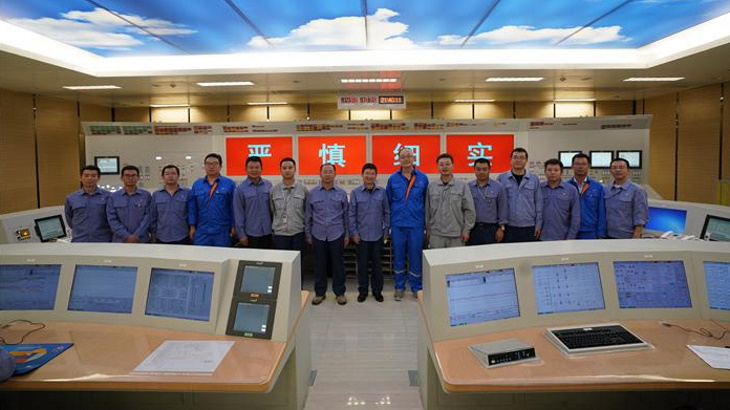Unit 5 of the Hongyanhe nuclear power plant in China's Liaoning province has completed commissioning tests and met the conditions for entering commercial operation, China General Nuclear (CGN) has announced. The company now has 25 power reactors in commercial operation with a combined generating capacity of 28,261 MWe.

Workers in the control room of Hongyanhe 5 mark its entry into commercial operation (Image: LHNPC)
At 9.32pm on 31 July, the 1080 MWe domestically-designed ACPR1000 pressurised water reactor completed a series of commissioning tests, including a test run lasting 168 hours, CGN said. Although the company must still obtain necessary permits and documentation, the unit can now be considered to be in commercial operation.
CGN said Hongyanhe 5's engineering design has fully implemented the nuclear safety requirements introduced after the accident at Japan's Fukushima Daiichi plant. It has implemented 36 technical improvements such as passive high-level cooling water sources, back-up water supplies and mobile emergency power supplies. The ACPR1000 design, it said, has the main technical characteristics of third-generation nuclear power plants with enhanced safety features.
In terms of equipment localisation, unit 5 uses the domestically-designed Hemu digital control system, which "expands the application of domestic equipment in key technical fields". The overall localisation rate of Hongyanhe units 5 and 6 reached 85%, CGN noted.
Construction of Phase I (units 1-4) of the Hongyanhe plant, comprising four CPR-1000 pressurised water reactors, began in August 2009. Units 1 and 2 have been in commercial operation since June 2013 and May 2014, respectively, while unit 3 entered commercial operation in August 2015 and unit 4 in September 2016.
Phase II of the Hongyanhe plant - units 5 and 6 - comprises two ACPR-1000 reactors. Construction of unit 5 began in March 2015 and that of unit 6 started in July the same year. Cold functional testing of unit 5 began on 10 October 2019, marking the start of its commissioning phase.
In late December 2019, CGN announced a change in the schedule for starting up units 5 and 6. It said the units were then expected to start operating in the second half of 2021 and the first half of 2022, which was, respectively, one year and six months later than previously scheduled.
Hongyanhe 5 achieved first criticality on 13 June this year and was connected to the electricity grid on 25 June. Unit 6 is currently undergoing hot functional testing.
The Hongyanhe plant is owned and operated by Liaoning Hongyanhe Nuclear Power Company (LHNPC), a joint venture between China General Nuclear and State Power Investment Corporation, each holding a 45% stake, with the Dalian Municipal Construction Investment Company holding the remaining 10%.
"The commercial operation of Unit 5 will further optimise the power structure of Northeast China and increase the proportion of clean energy," LHNPC said. "According to calculations, with five units now in operation, the annual on-grid power can reach 37.5 billion kWh, which is equivalent to about 15% of the annual power consumption of Liaoning Province."
Researched and written by World Nuclear News